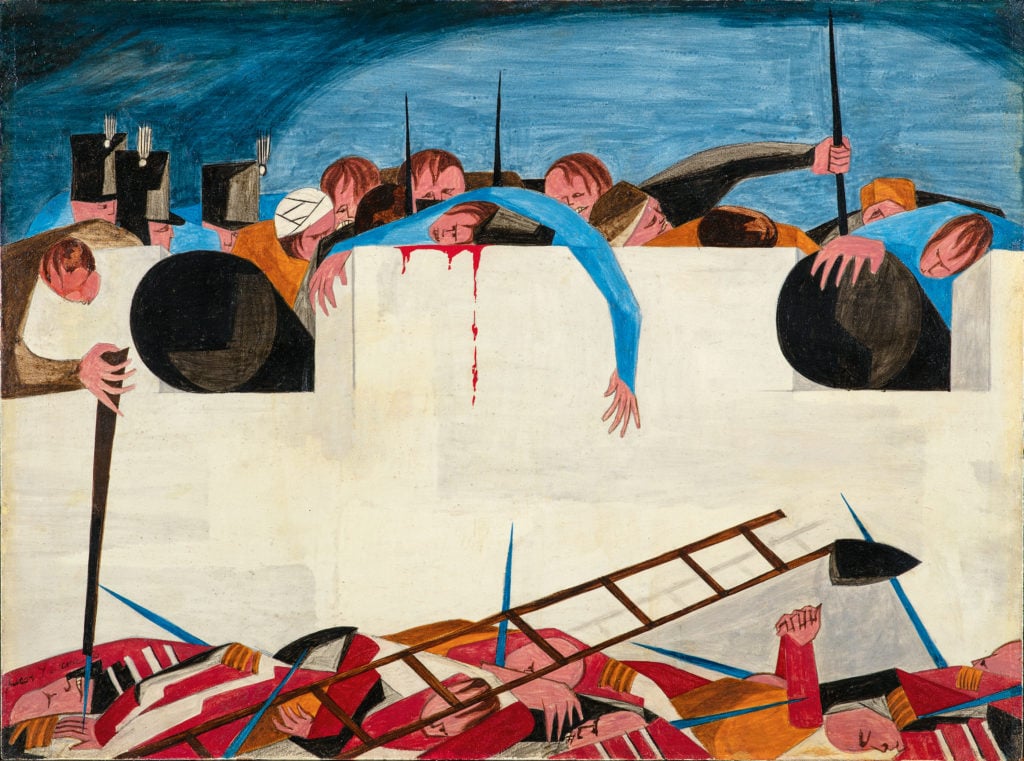On View
An Eagle-Eyed Art Lover Rediscovered a Long-Lost Jacob Lawrence Painting After Recognizing It in a Friend’s Apartment
The work is now on view as part of a larger show of the artist's work at the Metropolitan Museum of Art.

The work is now on view as part of a larger show of the artist's work at the Metropolitan Museum of Art.

Sarah Cascone

A sharp-eyed visitor to “Jacob Lawrence: The American Struggle,” an exhibition at the Metropolitan Museum of Art, has identified a long-lost artwork by the pioneering African American Modernist that was hiding in plain sight—just across the park from the museum.
The lost painting, which belongs to Lawrence’s “Struggle: From the History of the American People” series (1954–56), was missing for 60 years, and has now been reunited with its companion works for the exhibition. The panel belongs to two neighbors of the visitor who spotted the work, and was purchased by the couple on the cheap around Christmas 1960, at a charity auction for a music school.
The person who recognized the work had been to the Met exhibition, and suggested the couple reach out to the museum. (The couple that owns the painting are not art collectors and wish to remain anonymous.)
“It is rare to make a discovery of this significance in modern art, and it is thrilling that a local visitor is responsible,” Met director Max Hollein said in a statement.

Jacob Lawrence, Panel 27. . . . for freedom we want and will have, for we have served this cruel land long enuff . . . —A Georgia Slave, 1810, (1956). From Struggle Series, 1954–56. © The Jacob and Gwendolyn Lawrence Foundation, Seattle / Artists Rights Society (ARS), New York.
Randall Griffey and Sylvia Yount, who organized the traveling show’s Met iteration, were only CC’d on emails about the possible find last week.
Isabelle Duvernois, the Met’s modern paintings conservator, was promptly dispatched to the couple’s apartment and determined that not only was the painting authentic, it had been well cared-for and was ready to join the exhibition in short order.
“The painting has been hanging in my living room for 60 years untouched,” one of the owners told the New York Times. “I felt I owed it both to the artist and the Met to allow them to show the painting.”
Lawrence (1917–2000) painted the 30-panel “Struggle” series during the civil rights movement to highlight the roles of Black people, Native Americans, and women in building the country’s democracy.

Jacob Lawrence poses in his Seattle, Washington, studio. Photo by George Rose/Getty Images.
Unlike the artist’s nine other series, which are all owned in their entirety by public collections, “Struggle” was purchased by a private collector, William Meyers, after two shows at Charles Alan’s New York gallery failed to attract an institutional buyer. It hasn’t been seen all together since the dealer’s 1958 show.
Without a clause in the sales contract requiring the series stay intact, Meyers soon began selling the paintings individually. The current exhibition, which originated in January at the Peabody-Essex Museum in Salem, Massachusetts, is set to travel—in its newly expanded form—to Birmingham, Alabama; Seattle, Washington; and Washington, DC.
There were no existing photographs of the newly rediscovered work, panel 16 in the series, which was known only by its title, here are combustibles in every State, which a spark might set fire to. —Washington, 26 December 1786.
“Since reuniting the ‘Struggle series,’ the absence of panel 16 has been felt acutely. Represented in our galleries as an empty frame, it was a mystery that we were all eager to solve,” Peabody-Essex Museum director Brian Kennedy said in a statement. “We are thrilled to learn of its discovery—one that came about thanks to close looking and careful observation by a museum visitor.”

Jacob Lawrence, Panel 25. I cannot speak sufficiently in praise of the firmness and deliberation with which my whole line received their approach . . . —Andrew Jackson, New Orleans, 1815, (1956.) From Struggle Series, 1954–56. © The Jacob and Gwendolyn Lawrence Foundation, Seattle / Artists Rights Society (ARS), New York. Photo by Bob Packert/PEM.
The painting depicts Shays’s Rebellion, in which Revolutionary War veteran Daniel Shays led an uprising of struggling farmers in western Massachusetts in 1786 and ’87. The conflict, a protest against high taxes, is credited with helping to inspire the Founding Fathers to hold the Constitutional Convention.
“Lawrence’s dynamic treatment of the 1786–87 Shays’s Rebellion reinforces the overall theme of the series—that democratic change is possible only through the actions of engaged citizens, an argument as timely today as it was when the artist produced his radical paintings in the mid-1950s,” Griffey and Yount said in a joint statement.
Four paintings from the series remain missing. Another long-lost “Struggle” painting, panel 19, turned up at auction during planning for the current show. Art collector Harvey Ross, who owns half the series, spent $413,000 to buy Tensions on the High Seas at New York’s Swann Auction Galleries in 2018.
“Jacob Lawrence: The American Struggle” is on view at the Metropolitan Museum of Art, 1000 Fifth Avenue, August 29–November 1, 2020.